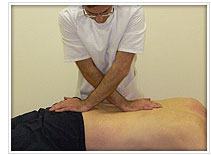Lower back Pain
If you have lower back pain, you are not alone. Nearly everyone has back pain at some point in their lives…
 Most commonly the cause of spinal pain is mechanical in nature. This means that it is the result of stress to the spinal bones and tissues. Repetitively sitting poorly or lifting improperly, a fall, sports injury or car accident causes trauma to the body’s soft-tissues. Similarly age-related disorders such as arthritis may result in stiffness and pain. Most commonly the cause of spinal pain is mechanical in nature. This means that it is the result of stress to the spinal bones and tissues. Repetitively sitting poorly or lifting improperly, a fall, sports injury or car accident causes trauma to the body’s soft-tissues. Similarly age-related disorders such as arthritis may result in stiffness and pain.
Symptoms may range from muscle ache to shooting or stabbing pain, limited flexibility and/or range of motion, or an inability to stand straight. Occasionally, pain felt in one part of the body may “radiate” from a disorder or injury elsewhere in the body.
What structures make up the back?
The back is an intricate structure of bones, muscles, and other tissues that form the posterior part of the body’s trunk, from the neck to the pelvis. The centrepiece is the spinal column; it supports the upper body’s weight and houses the spinal cord. The spaces between the vertebrae are spongy pads of cartilage called intervertebral discs that allow for flexibility in the lower back and act much like shock absorbers throughout the spinal column to cushion the bones as the body moves.
What causes lower back pain?
As we age our soft-tissues go through normal age-related changes. We become less flexible, our bone strength and muscle elasticity decrease making us vulnerable to trauma.
Should someone lift something too heavy or overstretch it may cause strain to the back’s muscles or ligaments or worse, rupture a disc. This rupture may put pressure on one of the nerves exiting the spine. When these nerve roots become compressed or irritated, back pain with leg pain may result.
Tips to a healthier back
Be careful not to alternate between a sedentary life style and a sport requiring heavy exertion. The body is organic and responds well to encouragement better than force .Following any period of prolonged inactivity, begin a program of regular low-impact exercises. Gentle walking for 30 minutes a day can increase muscle strength and flexibility.
- Always stretch before exercise or other strenuous physical activity.
- Don’t slouch when standing or sitting.
- At home or work, make sure your work surface is at a comfortable height for you.
- Sit in a chair with good lumbar support and proper position and height for the task. Periodically walk around the office or gently stretch muscles to relieve tension. A pillow or rolled-up towel placed behind the small of your back can provide some lumbar support. If you must sit for a long period of time, rest your feet on a low stool.
- Wear comfortable, low-heeled shoes.
- Sleep on your side to reduce any curve in your spine. Always sleep on a firm surface.
- Don’t try to lift objects too heavy for you. Lift with your knees. Keep the object close to your body and do not twist when lifting.
|








